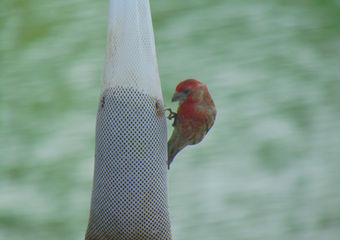House Finch
Common Name: House Finch.
Scientific Name: Haemorhous Mexicanus.
What to look for? The male House Finch has a festive appearance with its red head and breast. Its back is brown and noticeably streaked and it has a whitish belly with dark streaks. The wings have two pale wing bars each. The female House Finch is much drabber and lacks the all-red coloration of the male. Her brown body has distinct, blurry streaking above and below.
Where can they be found at Carillon Stonegate Pond? If you haven’t seen a House Finch recently, odds are you can find one at the next bird feeder you come across. During the winter, they are frequent feeders in small groups. You may also find them with Dark-eyed Juncos. Also look for House Finches feeding on the ground or perching high in nearby trees around Carillon Stonegate Pond.
How big are they? The House Finch averages just over five inches in length. And their wingspan is approximately nine inches. They weigh in at around ¾ of one ounce.
What are their flight patterns? The flight of the House Finch is bouncy and undulating, like many finches. This is called "Flap-Bounding" where short bursts of flapping are alternated with intervals in which the wings are folded against the body.
How else do they behave? House Finches are gregarious and social and generally found in large, noisy groups. The House Finch is rarely seen alone outside of the breeding season. When they are not at feeders, they feed on the ground, on weed stalks, or in trees. House Finches move slowly. You may see them sitting still as they shell seeds by crushing them with rapid bites.
What’s for dinner? House Finches eat almost exclusively plant materials, including seeds, buds and fruits. At feeders they eat sunflower seeds, millet, and milo.
Where do they take up residence? House Finches are a very common, often abundant resident throughout much of the U.S., extending north into much of extreme southern Canada and south into Mexico. House Finches frequent city parks, backyards, urban centers, farms, and forest edges.
When and where do they breed and nest? House Finches nest in a variety of deciduous and coniferous trees. They also nest in or on buildings, using sites like vents, ledges, street lamps, ivy, and hanging planters. Pairs may begin to form within flocks in winter, and some paired birds may remain together all year.
Where do they migrate? House Finches generally do not migrate. They are residents year around across most of the U.S. Some northern populations appear to be migratory, moving south in winter.
What is their conservation status? There is low concern. According to the North American Breeding Bird Survey, the House Finch has seen slight increases in populations. Partners in Flight estimates the global breeding population at 40 million.
Do they make any interesting sounds? House Finch calls are a sharp “cheep” made often, including while perched and during flight. Here is a link to the sounds of the House Finch.
Interesting Facts About the House Finch:
-
The House Finch was originally a bird of the western United States and Mexico. In 1940 a small number of finches were turned loose on Long Island, New York, after failed attempts to sell them as cage birds (“Hollywood finches”). They quickly started breeding and spread across almost all of the eastern United States and southern Canada within the next 50 years.
-
Partners in Flight estimates a global breeding population of 45 million House Finches.
-
The red of a male House Finch comes from pigments contained in its food during molt (birds can’t make bright red or yellow colors directly). So, the more pigment in the food, the redder the male.
-
House Finches feed their nestlings exclusively plant foods, a fairly rare occurrence in the bird world. Many birds that are vegetarians as adults still find animal foods to keep their fast-growing young supplied with protein.
-
The oldest known House Finch was approximately 12 years old.
For more information on the House Finch and sources of information used in this blog (these are the sources that I am using to learn as I blog), please visit All About Birds, Audubon Society and National Geographic. And the Cornell Lab of Ornithology provides a wonderful source of information for anyone interested in learning more about birds.
The Carillon at Stonegate community is very fortunate to have a variety of wetland, forest and prairie environments conducive to a variety of birds and other wildlife, plants and insects. Our community and the Kane County Forest Preserve do an exceptional job in maintaining this natural environment – both for the benefit of the birds and wildlife and for our residents to enjoy.
Take a hike and see what you can find – and identify!











